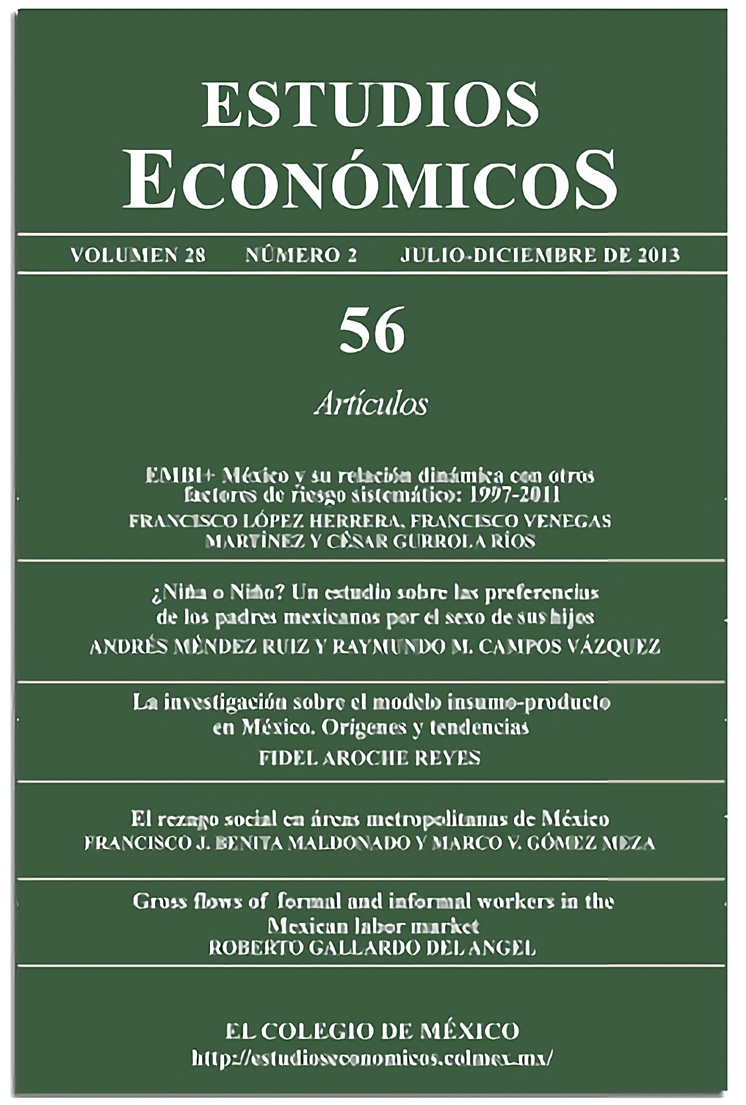Articles
Published 2013-07-01
Keywords
- fertility,
- family structure,
- preference for sons,
- Mexico
How to Cite
Méndez Ruiz, A., & Campos Vázquez, R. M. (2013). Girl or boy? A study on Mexican parents’ preferences for the sex of their children. Estudios Económicos De El Colegio De México, 28(2), 217–248. https://doi.org/10.24201/ee.v28i2.80
Abstract
Among Mexican parents child gender has an effect on family structure and fertility decisions. A first-born daughter increases the probability of father absence, of maternal custody in case of marital dissolution, of having more children and of a shorter elapsed period before a new child is born. The collection of evidence suggests that those effects are the result of a preference for sons among parents and not the result of other causes that could explain some of the results separately.
Downloads
Download data is not yet available.
References
- Ananat, E. y G. Michaels. 2008. The Effect of Marital Breakup on the Income Distribution of Women with Children, The Journal of Human Resources, 43(3): 611-629.
- Andersson, G. et al. 2006. Gendering Family Composition: Sex Preferences for Children and Childbearing Behavior in the Nordic Countries, Demography, 43(2): 255-267.
- Angrist, J. D. y J. S. Pischke. 2009. Mostly Harmless Econometrics: An Empiricist’s Companion, 1a. ed., Princeton University Press.
- Becker, G. S. y H. G. Lewis. 1973. On the Interaction between the Quantity and Quality of Children, Journal of Political Economy, 81(2): S279-S288.
- Bedard, K. y O. Deschênes. 2005. Sex Preferences, Marital Dissolution, and the Economic Status of Women, The Journal of Human Resources, 40(2): 411-434.
- Brockman, H. 2001. Girls Preferred? Changing Patterns of Sex Preferences in the Two German States, European Sociological Review, 17(2): 189-202.
- Cameron, A. C. y P. K. Trivedi. 2005. Microeconometrics: Methods and Applications, 1a. ed., Cambridge University Press.
- Dahl, G. B. y E. Moretti. 2008. The Demand for Sons, The Review of Economic Studies, 75(4): 1085-1120.
- Gray, E. y A. Evans. 2005. Parity Progression in Australia: What Role Does Sex of Existing Children Play?, Australian Journal of Social Issues, 40(4): 505-520.
- Hank, K. y H. P. Kohler. 2000. Gender Preferences for Children in Europe: Empirical Results from 17 FFS Countries, Demographic Research, 2(1), www.demographic-research.org/Volumes/Vol2/1/.
- Ichino, A., Lindström, E. A. y Viviano, E. 2010. Hidden Consequences of a First-Born Boy For Mothers: New Evidence and Critical Assessment of the Literature, IZA Discussion Paper, núm. 5649.
- INEGI. Censo de población y vivienda, México, varios años.
- Jacobsen, R., H. Møller y G. Engholm. 1999. Fertility Rates in Denmark in Relation to the Sexes of Preceding Children in the Family, Human Reproduction, 14(4): 1127-1130.
- Kaplan, E. L. y P. Meier. 1958. Nonparametric Estimation from Incomplete Observations, Journal of the American Statistical Association, 53: 457-481.
- Landsburg, S.E. 2008. Cuanto más sexo más seguro, 1a ed., Taurus.
- Lundberg, S. 2005. Sons, Daughters, and Parental Behavior, Oxford Review of Economic Policy, 21(3): 340-356.
- Marleau, J. D. y J. F. Saucier. 2002. Preference for a first-born boy in Western societies, Journal of Biosocial Science, 34: 13-27.
- Rojas, O. 2006. La importancia de tener un hijo varón y algunos cambios en la relación padre-hijo en México, Papeles de Población, 48: 181-204.

